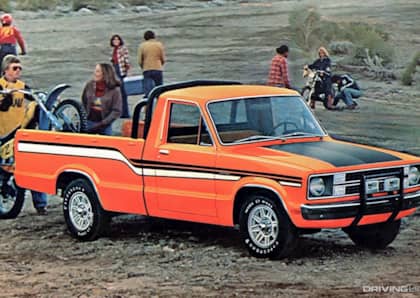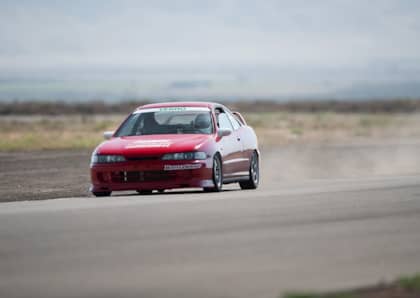The 10 Best Cars You Keep Forgetting About
Top 10 lists are almost always one of two things: predictable or wrong. Especially when it comes to the sort of cars boy-racer fantasies are made of. Even the nitwitted know that an Aventador’s gonna end up on just about any top-supercar list. But what about those cars you and pretty much every other top 10’s forgotten about? Turns out, they’re here, and in no particular order, and are anything but predictable.
1991-1992 Mitsubishi Galant VR-4

It’s the late 1980s and, as far as you’re concerned, Mitsubishi’s turbocharged and all-wheel-drive Evo was but a dot on the company’s drawing board. And those kids you decided to have, that meant that, all of a sudden, you needed a car with those two extra doors. Which is exactly what led you to the Galant VR-4 with its Eclipse-sharing 4G63 turbo engine and all-wheel-drive layout that paved the way for the nearly indestructible Evo you’d later find out about.
1988-1989 Isuzu Impulse Turbo

Remember the Impulse? Of course you don’t. But you do remember the small automaker that had a knack for naming cars that utterly embodied its Japanese heritage—like the Amigo. Or the Rodeo. It’s the Impulse, though, which you’ve completely forgotten about, that was available with a turbocharged and intercooled engine, a suspension designed by Lotus for the 1988 model year, and an exterior shaped by famed Italian car designer Giorgetto Giugiaro that, on paper, should’ve gone on to rival cars like Toyota’s MR2 but didn’t.
1994-2001 Acura Integra GS-R

Acura’s Integra Type R manages a place onto just about every other Top 10 list that cares about going fast and it ought to. So long as you plan on leaving that Type R unmodified. The GS-R, on the other hand, has long responded better to modifications than the Type R and, horsepower per dollar, will almost always make more sense. For as good as the Type R is, everything Acura did to make it better than the GS-R the aftermarket’s done more extensively. And cheaper.
1990-1993 Toyota Celica All-Trac Turbo

Forget about the MKIV Supra for just a minute and recall Toyota’s factory-turbocharged, all-wheel-drive compact that’s stuffed full of the same 3S-GTE that made the MR2 so famous, rendering it the most powerful Celica the U.S. has ever seen and on par power-wise with 5.0L Mustangs of its day. Consider it one of the original modified rally cars as far as us North Americans are concerned.
2014-2016 Chevrolet SS

It’s only been out for three years and you’ve already forgotten that the Chevy SS exists. But you shouldn’t have. Especially when there’s a 415hp V8 underneath the hood, Brembo brakes up front, and an optional six-speed manual gearbox to be had. You’ll look like you’re on your way to your job as a senior statistical analysis and data entry specialist while driving it, but you’ll do it while getting up to 60mph in about 4.6 seconds—almost as quick as a turn-of-the-century Z06.
1993-1997 Ford Probe GT

Forget about important things like invasive-sounding names, reliability or resale values for a minute and appreciate what was likely one of the best Ford-Mazda love-children the partnering companies ever conceived. The front-wheel-drive, six-cylinder Probe was designed as a Mustang replacement until Ford remembered that rear differentials and eight pistons were what made Mustangs so popular. The Probe held its own among cars like Toyota’s Celica and Nissan’s 200SX thanks to a capable suspension, a 24-valve Mazda V6 and a manual gearbox that was all sorts of fun so long as you remained south of the 100,000-mile mark.
1985-1989 Merkur XR4Ti

The name will never roll off of the tongue in the same sort of way that Camaro or Civic does, but the Camaro or Civic never had the SVO Mustang’s 175hp turbo engine underneath their hoods all while weighing less than 3,000lbs and with a rear-wheel-drive layout. Ask 1985 and it’ll tell you that the XR4Ti looked quite good. It’ll also tell you that the XR4Ti’s shape was rather purposeful and its rear spoiler as functional as its name was peculiar.
1982-1987 Mercedes-Benz 190E 2.3-16

The E30 M3 alternative, the 190E 2.3-16 was the result of Mercedes wanting to enter the World Rally Championship with its newly released compact sedan. Cosworth was called upon to rework the top half of the 16-valve, short-stroke engine, which netted 182hp from the four-cylinder if you didn’t get the wussified American model. The body kit that was every bit as purposeful as it was aesthetically pleasing as were the Recaro buckets positioned front and rear. Self-leveling air shocks, and brakes that’ll go against whatever it is that you drive today are but two reasons why you never should’ve forgotten about this particular 190E.
1986-1987 Dodge Omni GLHS

Among the few non-Fords to receive the Carroll Shelby treatment, the acronym GLHS stood for Goes Like Hell Some More, which is reason alone for you to want one. The little hatchback, of which only 500 were ever released by Shelby and were based off of the already impressive GLH-T—was good enough for low-14-second timeslips right off of the famed customizer’s showroom floor thanks to its modified 2.2L turbocharged powertrain that churned out 175hp.
1988-1989 Mazda 323 GTX

You had no reason to pay attention to the early ’80s 323 sub-compact until, like all great cars, a rally-bred homologation that you could actually own came to life. Predating cars like Subaru’s WRX and Mitsubishi’s Evo by a solid generation, like any good rally car, the GTX was built around an all-wheel-drive architecture, a 132hp, turbocharged four-cylinder engine, a locking center differential and a chassis stiffer and sleeker than the unpretentious-looking hatchback it was bred from. And it did all of this while weighing less than 2,600lbs.











